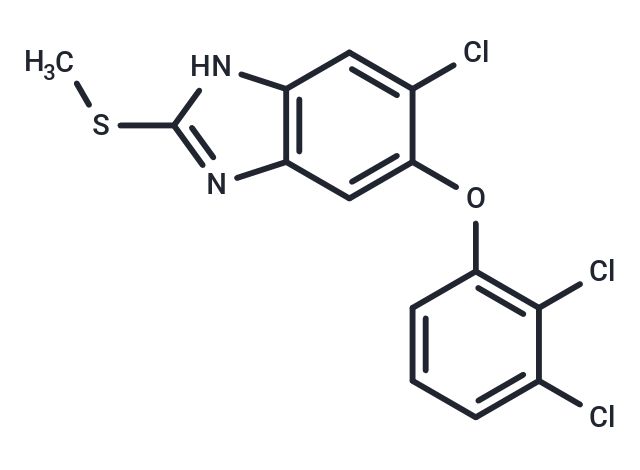Shopping Cart
Remove All Your shopping cart is currently empty
Your shopping cart is currently empty
Triclabendazole (CGA89317) has been used in trials studying Parasitic Disease.

| Pack Size | Price | USA Warehouse | Global Warehouse | Quantity |
|---|---|---|---|---|
| 25 mg | $44 | In Stock | In Stock | |
| 50 mg | $63 | In Stock | In Stock | |
| 100 mg | $79 | In Stock | In Stock | |
| 200 mg | $102 | In Stock | In Stock | |
| 500 mg | $167 | In Stock | In Stock | |
| 1 mL x 10 mM (in DMSO) | $50 | In Stock | In Stock |
| Description | Triclabendazole (CGA89317) has been used in trials studying Parasitic Disease. |
| In vitro | Triclabendazole treatment produces percentage decreases of the fluke egg output by 15.3%, 4.3% and 36.6%, respectively, in sheep, dairy cows and heifers, these results indicate the presence of TCBZ-resistant Fasciola hepatica in sheep and cattle on this farm. [1] Triclabendazole sulphoxide (50 mg/mL) results in extensive damage to the tegument of triclabendazole-susceptible F. hepatica, whereas triclabendazole-resistant flukes shows only localized and relatively minor disruption of the tegument covering the spines. [2] |
| Synonyms | CGA89317 |
| Molecular Weight | 359.66 |
| Formula | C14H9Cl3N2OS |
| Cas No. | 68786-66-3 |
| Smiles | CSC1=NC2=C(N1)C=C(Cl)C(OC1=C(Cl)C(Cl)=CC=C1)=C2 |
| Relative Density. | 1.59 g/cm3 |
| Color | White |
| Appearance | Solid |
| Storage | Powder: -20°C for 3 years | In solvent: -80°C for 1 year | Shipping with blue ice/Shipping at ambient temperature. | |||||||||||||||||||||||||||||||||||
| Solubility Information | DMSO: 60 mg/mL (166.82 mM), Sonication is recommended. H2O: < 1 mg/mL (insoluble or slightly soluble) Ethanol: < 1 mg/mL (insoluble or slightly soluble) | |||||||||||||||||||||||||||||||||||
| In Vivo Formulation | 10% DMSO+40% PEG300+5% Tween 80+45% Saline: 2 mg/mL (5.56 mM), Sonication is recommended. Please add the solvents sequentially, clarifying the solution as much as possible before adding the next one. Dissolve by heating and/or sonication if necessary. Working solution is recommended to be prepared and used immediately. The formulation provided above is for reference purposes only. In vivo formulations may vary and should be modified based on specific experimental conditions. | |||||||||||||||||||||||||||||||||||
Solution Preparation Table | ||||||||||||||||||||||||||||||||||||
DMSO
| ||||||||||||||||||||||||||||||||||||
| Size | Quantity | Unit Price | Amount | Operation |
|---|

Copyright © 2015-2025 TargetMol Chemicals Inc. All Rights Reserved.